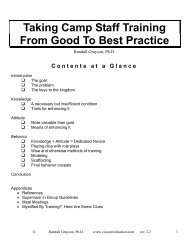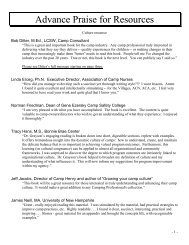Staff motivation - Vision Realization
Staff motivation - Vision Realization
Staff motivation - Vision Realization
Create successful ePaper yourself
Turn your PDF publications into a flip-book with our unique Google optimized e-Paper software.
Introduction<br />
What is <strong>motivation</strong>?<br />
Motivation is motion. When you have cohesive <strong>motivation</strong> (most of the staff), you have<br />
uniformity of motion. Leaving Webster behind, people are motivated by reaching for and achieving<br />
their dreams for themselves and others. That’s the core of it. Your staff’s dreams for others should be a<br />
good match with your dreams for others . . . your vision and mission. People also want to work on their<br />
personal dreams, and being specific about and focused on their growth will serve that end.<br />
On our way to our dreams, there are things that can either help us along, or be stumbling blocks.<br />
For example, empowering our staff by giving them the freedom to act, the security to be bold, the desire<br />
to succeed, and the opportunity to contribute will propel them along. Not setting proper expectations,<br />
not having enough staff to do the job, or doing any of the things discussed in the “10 great ways to demotivate<br />
your staff” section (page 100) will serve as stumbling blocks on their journey toward their<br />
dreams.<br />
Using and understanding this book<br />
Use this resource like a checklist. Most of the factors discussed contribute to staff <strong>motivation</strong><br />
by either fostering it or not deflating it, and many or most of them are likely already in place at your<br />
camp. Some of you may feel that all of these things are self-evident and even obvious. That’s fine, but<br />
do note whether or not they are in place, and how they can be more fully implemented. Carefully and<br />
rigorously assess your success – do not just take your own word for how well these elements are<br />
implemented.<br />
I’ve attempted to offer an overview of a <strong>motivation</strong>al system that will create a level of energy<br />
and dedication that equals best-practice camps. When most of these elements are essentially in place,<br />
the <strong>motivation</strong> the staff display is awe inspiring. They function at a level that exceeds what almost<br />
anyone would have thought possible! You will be amazed at how much your staff will happily<br />
accomplish, even if you were already satisfied with the way things were. This kind of staff far surpasses<br />
what the average camp experiences. This <strong>motivation</strong>al system serves as a critical element in creating an<br />
exceptional camp capable of achieving its outcomes to an unprecedented degree.<br />
“The three P’s” are what lots of people consider staff <strong>motivation</strong> – pep talks, praise, and perks.<br />
Relying on those elements is like eating your salad and dessert and saying you’re finished. The main<br />
course is: structures (quality, quantity, and pay), setting expectations, camp culture (including trust),<br />
empowered staff (freedom, security, desire, and opportunity), and providing value to your staff<br />
(development plans and reviews). Yes, with such a large meal, you could get by with less, but where<br />
the analogy breaks down is that when they are all present, the <strong>motivation</strong> of your staff will seem more<br />
magical than even your fanciful dreams. It is within such a comprehensive <strong>motivation</strong>al system that you<br />
will be able to get more from your staff without even asking.<br />
The blind man and the elephant<br />
No, I don’t think you’re an elephant, but stick with me through this analogy. There are several<br />
blind people around an elephant, and each one is describing the elephant differently – smooth, scaly,<br />
bushy, long and tube-like, and soft and mushy. You have to put all the pieces together to understand<br />
what an elephant is, and yet they can only really examine one part at a time. You have to feel (read)<br />
each part of the elephant (sections) to get the full picture.<br />
Since staff <strong>motivation</strong> must be viewed as a whole system (elephant), it might be a little<br />
confusing to examine each part and not understand the whole very well. After you’ve been through the<br />
whole book, go back to the contents at a glance page and I’ll wager that a new understanding washes<br />
over you. With that, you’ll be well equipped to truly motivate your staff.<br />
© 2004 Randall Grayson, Ph.D. 4





